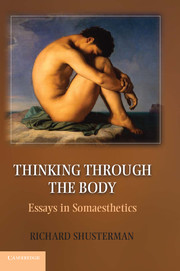Book contents
- Frontmatter
- Contents
- Preface
- Introduction
- Part I Somatic Being, Knowing, and Teaching
- Part II Somaesthetics, Aesthetics, and Culture
- Part III The Arts and the Art of Living
- 10 Somaesthetics and Architecture
- 11 Photography as Performative Process
- 12 Asian Ars Erotica and the Question of Sexual Aesthetics
- 13 Somaesthetic Awakening and the Art of Living
- 14 Somatic Style
- Select Bibliography
- Index
- References
10 - Somaesthetics and Architecture
A Critical Option
Published online by Cambridge University Press: 05 November 2012
- Frontmatter
- Contents
- Preface
- Introduction
- Part I Somatic Being, Knowing, and Teaching
- Part II Somaesthetics, Aesthetics, and Culture
- Part III The Arts and the Art of Living
- 10 Somaesthetics and Architecture
- 11 Photography as Performative Process
- 12 Asian Ars Erotica and the Question of Sexual Aesthetics
- 13 Somaesthetic Awakening and the Art of Living
- 14 Somatic Style
- Select Bibliography
- Index
- References
Summary
I
Criticality is a much discussed and contested issue in recent architectural theory. It is also clearly a topic that architecture shares with philosophy, as philosophy has long defined itself in terms of its fundamentally critical stance and methodology. The critique of dogma has been crucial to the philosophical project at least since Socrates, and perhaps constitutes the signature style of philosophical argumentation. In any case, such critique has been forcefully deployed throughout the field of philosophy, from logic, epistemology, and metaphysics to ethics, political theory, and aesthetics. In modernity, this essential critical function has even been thematized in the titles of some of modern philosophy's most influential books, not only the three famous critiques of Kant but also some of Marx's seminal works (Critique of Hegel's Philosophy of Right, Contribution to a Critique of Political Economy, Capital: The Critique of Political Economy, Critique of the Gotha Programme). While critique pervades the entire modern project of philosophy, the twentieth century has also witnessed the emergence of a school or movement of thought distinctively titled “Critical Theory.”
With respect to architecture, it is not simply modernity but more distinctively the twentieth-century's movement of modernism in which the notion of criticality emerged as increasingly central. Architecture was seen to have an important critical function in remaking the lived environment in the direction of progress, rationality, and democracy. Its new forms were to be an expression of a new critical and liberating spirit that by offering new forms of dwelling would introduce new ways of living as an alternative to the reigning social injustice, hardship, and exploitation. Consider a few brief examples.
- Type
- Chapter
- Information
- Thinking through the BodyEssays in Somaesthetics, pp. 219 - 238Publisher: Cambridge University PressPrint publication year: 2012



